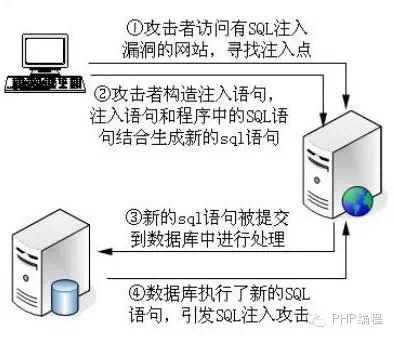SQL注入攻击(SQL Injection),是攻击者在表单中提交精心构造的sql语句,改动原来的sql语句,如果web程序没有对提交的数据经过检查,那么就会造成sql注入攻击。
SQL注入攻击的一般步骤:
1、攻击者访问有SQL注入漏洞的站点,寻找注入点
2、攻击者构造注入语句,注入语句和程序中的SQL语句结合生成新的sql语句
3、新的sql语句被提交到数据库中执行 处理
4、数据库执行了新的SQL语句,引发SQL注入攻击

实例
数据库
-
CREATE TABLE `postmessage` (
-
`id` int(11) NOT NULL auto_increment,
-
`subject` varchar(60) NOT NULL default ”,
-
`name` varchar(40) NOT NULL default ”,
-
`email` varchar(25) NOT NULL default ”,
-
`question` mediumtext NOT NULL,
-
`postdate` datetime NOT NULL default ’0000-00-00 00:00:00′,
-
PRIMARY KEY (`id`)
-
) ENGINE=MyISAM DEFAULT CHARSET=gb2312 COMMENT=’运用者的留言’ AUTO_INCREMENT=69 ;
-
grant all privileges on ch3.* to ‘sectop’@localhost identified by ’123456′;
-
//add.php 插入留言
-
//list.php 留言列表
-
//show.php 显示留言
页面 http://www.netsos.com.cn/show.php?id=71 可能存在注入点,我们来测试
http://www.netsos.com.cn/show.php?id=71 and 1=1
返回页面

一次查询到记录,一次没有,我们来看看源码
//show.php 12-15行
// 执行mysql查询语句
$query = "select * from postmessage where id = ".$_GET["id"];
$result = mysql_query($query)
or die("执行ySQL查询语句失败:" . mysql_error());
参数id传递进来后,和前面的字符串结合的sql语句放入数据库执行 查询
提交 and 1=1,语句变成select * from postmessage where id = 71 and 1=1 这语句前值后值都为真,and以后也为真,返回查询到的数据
提交 and 1=2,语句变成select * from postmessage where id = 71 and 1=2 这语句前值为真,后值为假,and以后为假,查询不到任何数据
正常的SQL查询,经过我们构造的语句之后,形成了SQL注入攻击。通过这个注入点,我们还可以进一步拿到权限,比如说运用 union读取管理密码,读取数据库信息,或者用mysql的load_file,into outfile等函数进一步渗透。
防范方法
整型参数:
运用 intval函数将数据转换成整数
函数原型
int intval(mixed var, int base)
var是要转换成整形的变量
base,可选,是基础数,默认是10
浮点型参数:
运用 floatval或doubleval函数分别转换单精度和双精度浮点型参数
函数原型
int floatval(mixed var)
var是要转换的变量
int doubleval(mixed var)
var是要转换的变量
字符型参数:
运用 addslashes函数来将单引号“’”转换成“’”,双引号“"”转换成“"”,反斜杠“”转换成“\”,NULL字符加上反斜杠“”
函数原型
string addslashes (string str)
str是要检查的字符串
那么刚才出现的代码漏洞,我们可以这样修补
// 执行mysql查询语句
$query = "select * from postmessage where id = ".intval($_GET["id"]);
$result = mysql_query($query)
or die("执行ySQL查询语句失败:" . mysql_error());
如果是字符型,先判断magic_quotes_gpc能无法 为On,当不为On的时候运用 addslashes转义特殊字符
-
if(get_magic_quotes_gpc())
-
{
-
$var = $_GET["var"];
-
}
-
else
-
{
-
$var = addslashes($_GET["var"]);
-
}
再次测试,漏洞已经修补